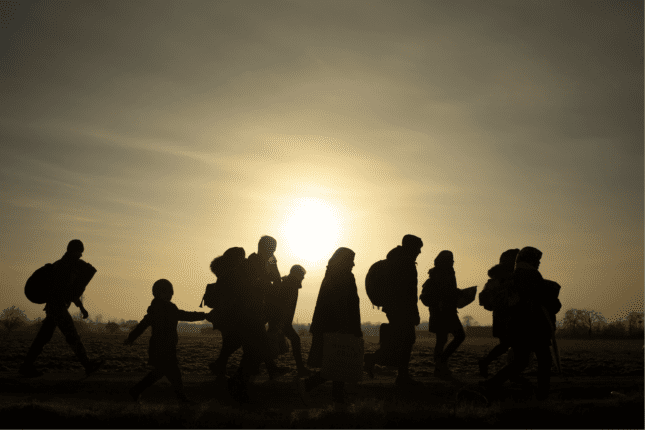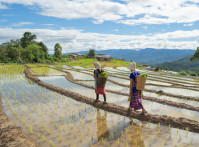-
Climate Change and Children’s Mobility

Environmental shocks have been linked to significant changes in human migration around the world. Yet the large literature on environmental change and migration to date has primarily focused on working-age adults, working largely on the assumption that climatic impacts are most likely to influence labor migration.
New research that we conducted with our colleague Emma Barber suggests that other age groups also are impacted by environmental shocks in ways that may influence their mobility. Our recent study, published in the journal Population and Environment, investigated the association between precipitation and temperature variability and child fostering— or the migration of children from the households of their biological parents— across almost two dozen sub-Saharan African countries.
Our study of links between climate variability and child fostering pooled Demographic and Health Survey (DHS) data from 23 sub-Saharan African countries accessed using IPUMS-DHS, then compared them with high resolution precipitation and temperature data. We then fit a series of statistical models that attempted to isolate the relationships between temperature and precipitation anomalies. We sought to know how far conditions in each person’s village during the year prior to the interview varied from that location’s average, as well as the likelihood a household had one or more in- and out-fostered children, respectively.
Our work establishes new associations between climate impacts and fostering along with raising significant new questions ripe for exploration. Broadly speaking, our findings suggest migration in response to environmental shocks is not restricted to working age adults and may extend across the life course.
Fostering Patterns Following Droughts and Heat Waves
Our research analyzed child fostering arrangements where a household sends one or more children to live with family, friends, or other relations. These arrangements are also sometimes referred to as kinship care. Households may “out-foster”—or send a child to live outside of the home—to reduce household resource demand, or help a child obtain better educational opportunities, or for other reasons. Households may also “in-foster”—or take in—a non-biological child to provide household labor, or to provide that child with educational advantages.
Importantly, the decision to out- or in-foster a child may occur for multiple, and sometimes intersecting reasons. In some circumstances, it can be beneficial for children and the associated households. Yet the incentives for in- and out-fostering are likely to be strengthened in the aftermath of environmental shocks, when many households face new resource constraints.
For example, high temperatures and low precipitation may result in lower agricultural yields and reduced income, which could both encourage out-fostering and discourage some forms of in-fostering in order to limit family size and an accompanying demand for resources. Alternatively, the economic consequences of environmental shocks may increase the labor needed to complete tasks commonly assigned to children (e.g. collecting water or firewood), and therefore incentivize in-fostering.
Our analysis showed exposure to precipitation deficits is associated with a decrease in in-fostering during the following year. This association is particularly strong among households with better-educated heads, as well as in countries where fostering is relatively common. These relationships may occur because in-fostering is typically more likely among better-resourced households and countries with stronger fostering norms and less likely among households with less-educated households and in countries with lower prevalences of child fostering.
Another key finding in our work? Exposure to heat shocks increases the likelihood that a household in-fostered a child during the following year in places with higher prevalences of child fostering. This finding is consistent with a scenario in which households in-foster to meet heat-induced increases in the demand for household labor.
Somewhat surprisingly, we found no overall relationship between precipitation or temperature and child out-fostering. However, we found evidence of climate effects on out-fostering among some sub-groups of households. Specifically, heat shocks were associated with an increase in out-fostering in the following year among households with better-educated heads, while precipitation deficits were associated with an increased likelihood of out-fostering among households with many children.
The latter finding on precipitation deficits may occur because larger households (given their size) are more susceptible to heat-induced resource constraints. Alternatively, these households may have enough children to adapt to heat-related increases in household labor, In practical terms, out-fostering can be used in such situations to improve the standing of the affected child (e.g., by sending them to a more food-secure household) without much cost to the household. Better-resourced households may be more likely to out-foster a child in response to precipitation deficits because they may have more social or economic resources to support this practice.
Answers That Create New Questions
Like all studies, our analysis has limitations that raises questions for future research. For example, we are unable to measure the exact timing of child fostering with our available data. The very large sample from 23 countries provided statistical power for our study, but it does not allow us to account for the many social and environmental differences between contexts.
More work is needed to understand when, why, and for how long environmental changes can affect children’s mobility and living arrangements. These limitations do highlight the need for higher-quality data on migration that will permit further study of fostering and other forms of geographic mobility among children, as well as allow for comparisons with migration behaviors of adults in their families and communities.
Our findings should provide motivation for further study of links between environmental shocks and child fostering—and why they exist. Fostering can be beneficial for children if it provides them access to better nutrition or educational opportunities. Yet it may also be detrimental to a child’s well-being if they are given many household responsibilities that interfere with their education or health. These impacts suggest that some climate-related changes in children’s health and well-being may occur through child fostering. Further investigation into the links between environmental shocks, child fostering, and children’s wellbeing is needed to fully understand the implications of climate change for children.
The paper published in Population and Environment on which this article is based, “Child fostering in a changing climate: evidence from sub-Saharan Africa,” received the 2023 IPUMS research award for best graduate student-led paper using global health data.
Sara Ronnkvist is a sociology PhD student at the University of Wisconsin – Madison and a Center for Demography and Ecology predoctoral fellow. Her work broadly studies demographic responses to environmental change, with a focus on migration, health, and fertility outcomes.
Brian Thiede is an associate professor of rural sociology, sociology, and demography at The Pennsylvania State University. His research focuses on the links between environmental change, conflict, and demographic and health outcomes.
Sources: Population and Environment; IPUMS
Photo credit: Migrants walk towards the Turkey’s Pazarkule border crossing with Greece’s Kastanies, in Edirne, Turkey March 1, 2020, courtesy of Lumiereist/Shutterstock.com.
 A Publication of the Stimson Center.
A Publication of the Stimson Center.







